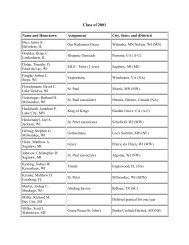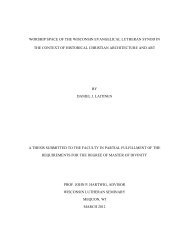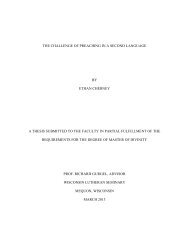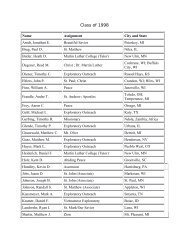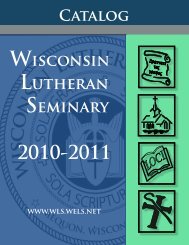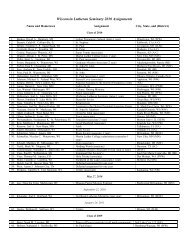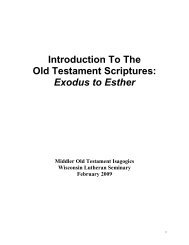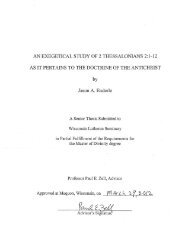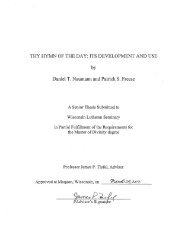Untitled - Wisconsin Lutheran Seminary - WELS
Untitled - Wisconsin Lutheran Seminary - WELS
Untitled - Wisconsin Lutheran Seminary - WELS
You also want an ePaper? Increase the reach of your titles
YUMPU automatically turns print PDFs into web optimized ePapers that Google loves.
temple (τοῦ ναοῦ) he had spoken of was his body” (Jn 2:21). John later in his book of Revelation<br />
uses the term τὸν ναὸν to describe a heavenly sanctuary, not the temple in Jerusalem.<br />
To suggest that the ναός here refers to the temple in Jerusalem would also be forcing a<br />
meaning upon Paul that he does not use in his letters. Paul uses the term ναός in three other<br />
letters (1 Co 3:16, 17; 6:19; 2 Co 6:16; Eph 2:21). Paul, speaking to believers in Corinth, says,<br />
“Don’t you know that you yourselves are God’s temple (ναὸς θεοῦ) and that God’s Spirit lives in<br />
you If anyone destroys God’s temple (τὸν ναὸν τοῦ θεοῦ), God will destroy him; for God’s<br />
temple (ὁ ναὸς τοῦ θεοῦ) is sacred, and you are that temple” (1 Cor 3:16,17). Later in chapter<br />
6:19 he speaks of the believer’s body as a temple: “Do you not know that your body is a temple<br />
(ναὸς) of the Holy Spirit, who is in you, whom you have received from God” Also in his second<br />
letter to that congregation he writes to fellow Christian believers saying, “We are the temple<br />
(ναὸς θεοῦ) of the living God” (2 Cor 6:16). Then in Ephesians 2:21, while speaking of Jews and<br />
Gentiles being united together in the body of Christ, he says, “In [Christ] the whole building is<br />
joined together and rises to become a holy temple (ναὸν) in the Lord.” In all of these references<br />
Paul does not use ναός in reference to the temple in Jerusalem but in reference to the gathering of<br />
believers, united in Christ with the Spirit dwelling in each one. He uses ναός in the imagery of a<br />
human body, “of the spirit-filled body of Christians, which is said to be the habitation of God,<br />
therefore a temple.” 53<br />
In light of the statement he makes in the following verse, “when I was with you I used to<br />
tell you these things,” together with the understanding that he proclaimed the same message in<br />
every city he entered during his missionary journeys, one is lead to understand his language to be<br />
the same in all his letters. Scripture seems to give evidence of the unchanging message about<br />
which Paul preached and wrote. In the book of Acts, Luke records Paul’s visit to Thessalonica<br />
saying, “They came to Thessalonica, where there was a Jewish synagogue. As his custom was,<br />
Paul went into the synagogue, and on three Sabbath days he reasoned with them from the<br />
Scriptures, explaining and proving that the Christ had to suffer and rise from the dead” (Ac<br />
17:1b-3a). Paul himself in his first letter to the Corinthians states the consistency of his message,<br />
“For I resolved to know nothing while I was with you except Jesus Christ and him crucified” (1<br />
53 Walter Bauer. A Greek-English Lexicon of the New Testament and Other Early Christian Literature, 3rd<br />
Edition. 3rd ed. (University Of Chicago Press, 2001), Libronix.<br />
28




